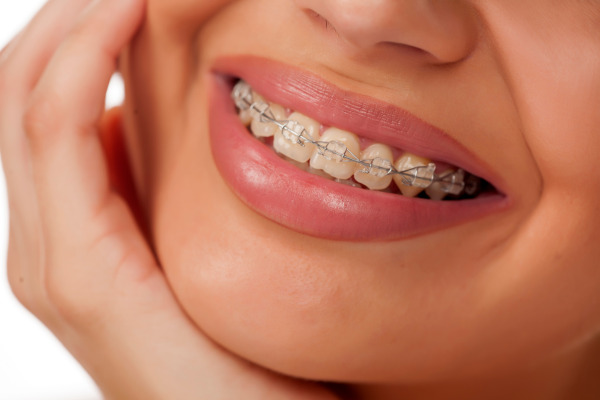
Table of Contents
- What Are Clear Braces?
- So, Are Clear Braces Really Invisible?
- Clear Braces vs Invisible Aligners
- How Noticeable Are Clear Braces in Daily Life?
- Do Clear Braces Stain Easily?
- Why Are Adults Choosing Clear Braces?
- How to Maximize the Discreetness of Clear Braces?
- Final Takeaways: Are Clear Braces Really Invisible?
- FAQs
Are clear braces really invisible? Clear braces offer a subtler look with the same effectiveness as metal braces, almost like the best of both worlds. But do they truly live up to their name?
Let's address the science behind clear braces, how they compare with other invisible alternatives, and what you can expect from them in terms of aesthetics and effectiveness.
What Are Clear Braces?
Clear braces, also called ceramic braces, work the same way as metal braces. They use small brackets and wires to move your teeth slowly into the right place. The main difference is the material: instead of shiny metal, the brackets are made of tooth-colored or clear ceramic. This makes them much harder to see on your teeth.
The wire connecting the brackets may also be tooth-colored or white, though sometimes a regular metal wire is still used, depending on your dental needs. The small rubber bands (called ligatures) used with clear braces are usually clear or off-white, helping keep the braces less noticeable.
Even though they’re called “clear,” it doesn’t mean they’re invisible—just less noticeable than metal ones.
So, Are Clear Braces Really Invisible?
No, they’re not completely invisible. But they’re less visible than regular metal braces. That’s why many people choose them; they’re a good middle option for those who want something subtle but still effective.
So, it’s better to think of them as “low-visibility” instead of “invisible.”
Clear Braces vs Invisible Aligners
| Feature | Clear Braces | Invisible Aligners |
|---|---|---|
| Visibility | Low visibility but still noticeable up close | Nearly invisible even in close conversations |
| Material | Ceramic or porcelain brackets with wires | Clear BPA-free plastic trays |
| Fixed or Removable | Fixed, cannot be removed by the patient | Removable, can be taken out for eating and brushing |
| Comfort | May irritate due to brackets and wires | Generally more comfortable with no sharp edges |
| Effectiveness | Highly effective for mild to complex cases | Best for mild to moderate corrections |
| Food Restrictions | Yes, avoid sticky, hard, or staining foods | Fewer restrictions, aligners are removed before eating |
| Oral Hygiene | Harder to clean around brackets and wires | Easier to brush and floss without obstruction |
| Adjustments | Requires in-office adjustments by an orthodontist | New sets of aligners are provided every 1-2 weeks |
| Discipline Required | Minimal, treatment is continuous | Must be worn 20–22 hours per day |
| Treatment Duration | Often 18–24 months | Typically 6–18 months, depending on the case |
| Cost | Generally, more expensive than metal braces | Can range from affordable to premium based on the provider. |
How Noticeable Are Clear Braces in Daily Life?
Most people who wear clear braces report feeling less self-conscious compared to those who wear metal braces. In everyday conversations or normal lighting, they’re barely noticeable.
However, in strong light, with flash, or when taking close-up shots, the brackets can be visible. Over time, the elastics used to hold the wires may become stained by foods like coffee, tea, curry, or red wine, which makes them more noticeable.
So, while they’re not completely hidden, clear braces still offer a good mix of subtle looks and strong results.
Do Clear Braces Stain Easily?
The ceramic or porcelain brackets don’t stain easily. But the elastic ties (those small rubber bands) can stain pretty quickly, especially from foods and drinks like coffee, curry, or red wine.
To avoid this, your orthodontist will change them at every appointment (about every 4–6 weeks). You can also help by:
- Avoiding dark-colored food and drinks
- Using a straw when drinking things like iced coffee or soda
- Brushing and flossing regularly
Why Are Adults Choosing Clear Braces?
More adults are getting clear braces today. They offer the same strength and precision as metal braces but look much better. For busy professionals and parents, clear braces for adults offer a discreet, low-maintenance way to straighten teeth without disrupting daily life.
Also, some dental issues are too complex for aligners. For those cases, clear braces offer the best mix of performance and appearance.
How to Maximize the Discreetness of Clear Braces?
If you want your clear braces to stay as unnoticeable as possible, here are some tips:
- Brush and floss after meals to avoid staining the rubber bands
- Stay away from food and drinks that stain (like coffee and curry)
- Use a straw when drinking colored beverages
- Visit your orthodontist regularly to get fresh elastic ties
- Use orthodontic wax to avoid irritation and help you smile confidently
Final Takeaways: Are Clear Braces Really Invisible?
Clear braces aren't completely invisible, but they're a good choice for people who want strong, reliable results without the look of traditional braces.
They’re not as hidden as clear aligners , but they’re a smart middle ground, especially for adults and teens who need more serious straightening. If you take care of them and avoid things that stain, clear braces can stay looking neat and help you smile with confidence as your teeth improve.
FAQs
1. How visible are clear braces?
Clear braces are less noticeable than metal braces, but not completely invisible. They blend with your teeth but still use brackets and wires.
2. What are the negatives of clear braces?
They can stain over time, may be less comfortable than aligners, and are fixed, meaning you can’t remove them for eating or brushing.
3. Are invisible braces really invisible?
Not entirely. "Invisible" braces like aligners are very discreet, but up close, they can still be seen slightly.
Citations:
Karamouzos, A., Athanasiou, A. E., & Papadopoulos, M. A. (2006). Perception of facial profile attractiveness of southern Europeans. The Angle Orthodontist, 76(6), 962–967. https://doi.org/10.2319/112005-408
Pithon, M. M., Santos, A. M., Campos, M. S., Couto, F. S., Coqueiro, R. D. S., de Andrade, A. C. S., & Paranhos, L. R. (2012). Perception of esthetics with the use of orthodontic appliances. American Journal of Orthodontics and Dentofacial Orthopedics, 142(2), 144–149. https://doi.org/10.1016/j.ajodo.2012.03.017
Rosvall, M. D., Fields, H. W., Ziuchkovski, J., Rosenstiel, S. F., & Johnston, W. M. (2009). Attractiveness, acceptability, and value of orthodontic appliances. American Journal of Orthodontics and Dentofacial Orthopedics, 135(3), 276.e1–276.e12. https://doi.org/10.1016/j.ajodo.2008.09.010





